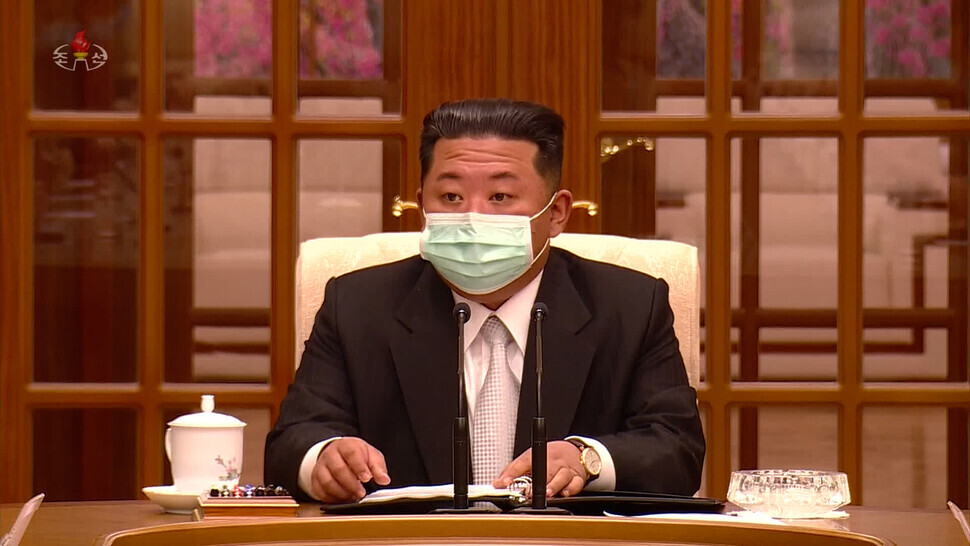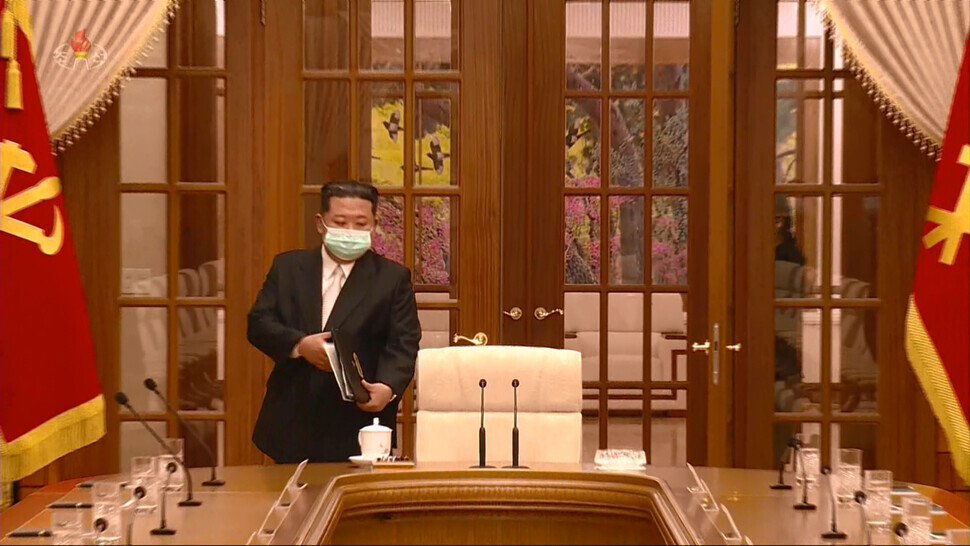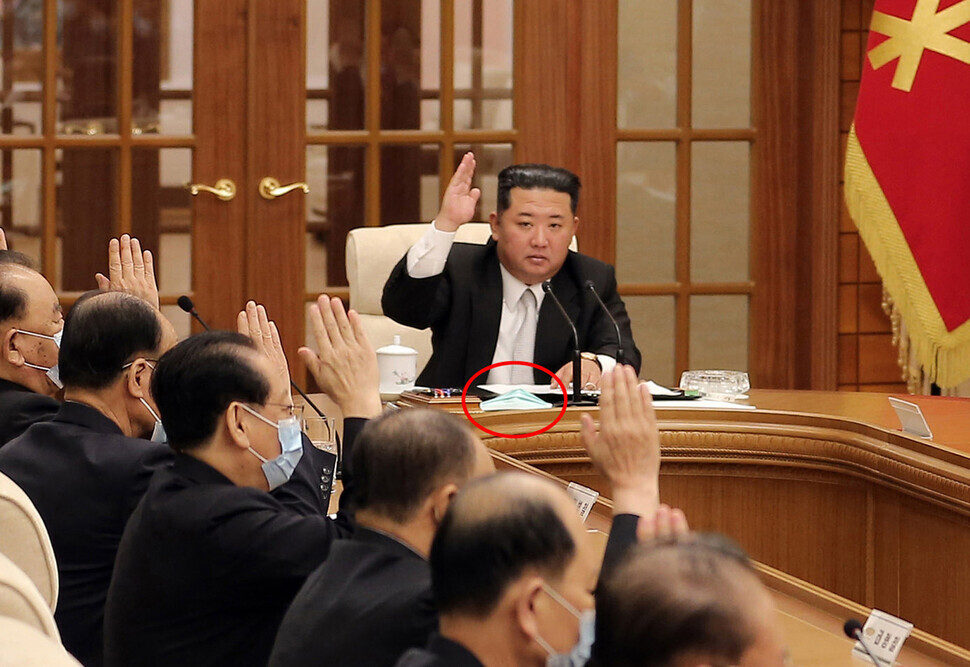hankyoreh
Links to other country sites 다른 나라 사이트 링크
As N. Korea reports COVID-19 outbreak, some hope it will prompt inter-Korean cooperation

North Korea has finally succumbed to the worldwide COVID-19 pandemic. During a Politburo meeting held Thursday morning, North Korean leader Kim Jong-un confirmed the country’s first positive case of the Omicron variant of the COVID-19 virus and announced that the country will be switching over to a “maximum emergency epidemic prevention system.”
While the COVID-19 virus ravaged the world beginning in January 2020, Kim touted North Korea’s status as a “COVID-free country” as his greatest administrative achievement. Now, his crisis management will be put to the test. Kim attended Thursday’s meeting wearing a face mask — the first time he did so during a public event. It was a symbolic move that showed how seriously Kim is taking the situation in North Korea.
The spread of COVID-19 within its borders will pose an immense challenge to North Korea, as the country lacks adequate medical and disease control infrastructure. Paik Soon-young, an emeritus professor at the Catholic University of Korea, said, “Because vaccination has been unavailable in North Korea, every member of its population will be highly susceptible to infection, which will inevitably lead to high transmission and a higher rate of severe cases once infections occur.”
“Vaccinations should take place as soon as possible to minimize damage,” he added.
Some are hopeful that if North Korea accepts humanitarian assistance from the international community including South Korea and the US as it responds to COVID-19, a window of opportunity may open up that may initiate dialogue on the Korean Peninsula, where conditions have been steadily deteriorating.
In South Korea, the Yoon Suk-yeol administration stressed its willingness to cooperate on disease control efforts — suggesting its intent to use the situation as an opportunity.

In his confirmation hearing Thursday, minister of unification nominee Kwon Young-se announced plans to prepare to provide “humanitarian aid, since that is something we can do regardless of sanctions.”
“In addition to vaccines, we will prepare to provide support when possible in terms of pain relievers, antipyretics, and other medications to treat symptoms, as well as syringes and sterilizing agents,” he said.
But in the Politburo meeting that day, Kim Jong-un made no mention of the need for cooperation with the UN or the international community in general, not even a request for assistance with vaccines.
Instead, he called for “strictly conduct[ing] intensive examination[s] of all the people” and “intensify[ing] disinfection of all areas,” while “mobiliz[ing] reserve medical supplies.”
“The people-first politics by our Party and state [. . .] and the strength of our people who are united single-mindedly are the most powerful guarantee to win victory in the current great epidemic prevention campaign,” Kim was quoted as saying. His remarks amounted to a declaration that for now, Pyongyang plans to confront the spread of COVID-19 by stepping up internal disease control measures on top of the closure of its national borders, which has continued for two years and four months since Jan. 20, 2020.

While he announced that a “most serious emergency case of the state occurred,” Kim did not opt for a full-scale lockdown. Instead, he stressed that “there should be nothing missed in the planned economic work.” In effect, he set forward a very difficult policy approach: increasing disease control efforts while ramping up production.
In addition to rejecting past offers of vaccines from China and Russia due to “reliability” issues, Kim has not been receptive to vaccine cooperation proposals from the Joe Biden administration in the US or the Moon Jae-in administration in South Korea. This explains why former senior South Korean government officials who have dealt with Pyongyang in the past view the possibility of him requesting vaccine assistance from the outside as “still very slim.”
Kim made plans for convening the 5th Plenary Meeting of the 8th Central Committee of the Workers’ Party of Korea in early June. Analysts predicted he would review the results of disease prevention measures until then and the outcome of a May 21 summit between South Korea and the US before deciding on whether to adjust the current disease control approach and policies toward Seoul and Washington.
By Lee Je-hun, senior staff writer; Park June-yong, staff reporter
Please direct questions or comments to [english@hani.co.kr]

Editorial・opinion
![[Editorial] Penalties for airing allegations against Korea’s first lady endanger free press [Editorial] Penalties for airing allegations against Korea’s first lady endanger free press](https://flexible.img.hani.co.kr/flexible/normal/500/300/imgdb/original/2024/0502/1817146398095106.jpg) [Editorial] Penalties for airing allegations against Korea’s first lady endanger free press
[Editorial] Penalties for airing allegations against Korea’s first lady endanger free press![[Editorial] Yoon must halt procurement of SM-3 interceptor missiles [Editorial] Yoon must halt procurement of SM-3 interceptor missiles](https://flexible.img.hani.co.kr/flexible/normal/500/300/imgdb/child/2024/0501/17145495551605_1717145495195344.jpg) [Editorial] Yoon must halt procurement of SM-3 interceptor missiles
[Editorial] Yoon must halt procurement of SM-3 interceptor missiles- [Guest essay] Maybe Korea’s rapid population decline is an opportunity, not a crisis
- [Column] Can Yoon steer diplomacy with Russia, China back on track?
- [Column] Season 2 of special prosecutor probe may be coming to Korea soon
- [Column] Park Geun-hye déjà vu in Yoon Suk-yeol
- [Editorial] New weight of N. Korea’s nuclear threats makes dialogue all the more urgent
- [Guest essay] The real reason Korea’s new right wants to dub Rhee a founding father
- [Column] ‘Choson’: Is it time we start referring to N. Korea in its own terms?
- [Editorial] Japan’s rewriting of history with Korea has gone too far
Most viewed articles
- 160% of young Koreans see no need to have kids after marriage
- 2Presidential office warns of veto in response to opposition passing special counsel probe act
- 3[Editorial] Penalties for airing allegations against Korea’s first lady endanger free press
- 4Months and months of overdue wages are pushing migrant workers in Korea into debt
- 5Japan says it’s not pressuring Naver to sell Line, but Korean insiders say otherwise
- 630th anniversary Wednesday Demonstration pushed out of memorial site by far-right
- 7S. Korea “monitoring developments” after report of secret Chinese police station in Seoul
- 8[Reporter’s notebook] In Min’s world, she’s the artist — and NewJeans is her art
- 9[Special reportage- part I] Attending the funeral of the victim of a South Korean war crime in Vietn
- 10Kolon TissueGene was aware of risky cell alterations in treatment for 2 years